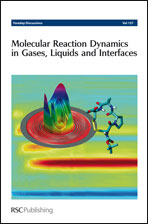There has been a long standing controversy over the preferential presence or absence of cations vs. anions at the gas–liquid interface, dating back to early theoretical efforts by Onsager and co-workers [J. Chem. Phys., 1934, 2, 528]. In the present work, we describe our first efforts to selectively probe ions at the interface via a completely novel approach, based on scattering high energy, jet cooled molecular projectiles from the surface of hydrogen bonded liquids with dissolved alkali halide salts as the source of solvated charges. In particular, this work focuses on preliminary results from quantum state- resolved scattering studies as a function of anion (Cl−, I−), and cation identity (Li+, Na+, K+) in alkali halide/glycerol solutions. By way of physical picture, a quadrupolar projectile such as CO2 preferentially aligns parallel (anions) or perpendicular (cations) to the interface, which could therefore make rotational energy transfer sensitive to the sign of the ion charge. Experimentally, we find that the impulsive scattered (IS) CO2 rotational distributions reveal a clear dependence on anion identity (e.g., hotter for [I−] than [Cl−]), but with essentially no corresponding sensitivity to cation species (e.g., [Li+] indistinguishable from [K+]). Detailed trajectory calculations are used to provide additional insight into the anticipated and observed experimental trends.

 Please wait while we load your content...
Please wait while we load your content...